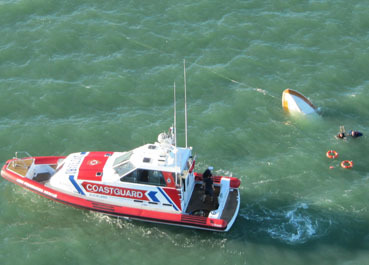Blogs
EPIRB BUYERS GUIDE
NZ Fishing World
By John Durrant June 10, 2013
The average fisho is, thankfully, becoming more safety-savvy. As part of that, it’s essential to have the latest safety equipment onboard or on your person whether you’re fishing at sea, on the lake or land-based.
EPIRBS (Emergency Position Indicating Radio Beacons) and PLBs (Personal Locator Beacons) were, at one time, horrendously expensive and out of reach of the budget of most fishos. But not now. Advances in the technology behind these potential lifesavers have resulted in a dramatic reduction in the average prices.
Some of the most popular PLBs and EPIRBs can be bought for as little as $600 these days.
EPIRB or PLB?
The most important question for most fishos is which unit to choose. Both have their advantages and, as you would expect, their disadvantages.
Ryan Archer, northern region sales manager for Survitec Group – responsible for Kannad Marine products – explained: “The main difference between the two is that EPIRBs tend to be a little more cumbersome and are usually fixed to a boat whereas PLBs are smaller, lighter and more easily carried on your person. “EPIRBS are typically registered to a vessel whereas a PLB will be registered to a person.
“The benefit in this is that a lot of people who tend to use smaller boats are probably also more likely to want to use the PLB for other activities such as hunting or tramping.
“EPIRBs are able to transmit for longer though. Typically an EPIRB will transmit for around 48 hours and a PLB for around 24 hours, depending on the model.”
EPIRB categories:
Category I - 406/121.5 MHz. Float-free, automatically activated EPIRB. Detectable by satellite anywhere in the world.
Recognized by GMDSS.
Category II - 406/121.5 MHz. Similar to Category I, except is manually activated. Some models are also water activated.
ACR ResQLink – PLB
ResQLink offers more power output than some other larger models. It’s ideal for canoeing, camping, hunting, kayaking or mountain climbing. Featuring three levels of integrated signal technology - GPS positioning, a powerful 406 MHz signal and 121.5 MHz homing capability - the Res-Q-Link quickly and accurately relays your position to a worldwide network of search and rescue satellites, reducing search time and increasing your chances of survival. What's more, the Res-Q-Link is small enough to be easily carried in a pack or pocket and will float if accidentally dropped overboard.
Ocean Signal RescueMe – PLB
The world’s smallest PLB is the Ocean Signal RescueMe PLB1. The RescueMe PLB1 is about a third smaller than other PLBs and is ideal for all outdoor activities, including hunting, tramping, cycling and boating. Designed to easily attach to virtually any outdoor clothing, it is simple to activate, using just one hand, even in the most challenging of conditions. Users simply extend the antenna, flip up the protective cover and push a button. When activated, the RescueMe PLB1 will transmit accurate position data from its 66 channel GPS (using the designated 406MHz search and rescue satellite communication system), as well as transmitting a 121.5MHz homing beacon (which will be received by search and rescue helicopters or vessels) for a minimum of 24 hours, while the integrated strobe light ensures maximum visibility.
CLICK HERE to go to more details on the RescueMe or to make a purchase
Kannad SafeLink SOLO – PLB
The SafeLink SOLO Category 2 406 MHz GPS PLB gives you direct contact with search and rescue services when a life-threatening incident occurs anywhere in the world. The ultra-small SafeLink SOLO is tough and durable, lightweight and compact, and designed to be carried with you at all times. The size of the SafeLink SOLO and its non-slip rubber armour - designed to protect it in the harshest environments - means the compact lifesaver can be tucked into a pocket, pouch or personal kit bag and forgotten about until needed. SafeLink SOLO is waterproof to 10 metres and activation is simple.It is supplied complete with a lanyard, a buoyancy pouch and a universal carry pouch, which can be attached to a belt or strap.
Ocean Signal SafeSea – EPIRB
SafeSea EPIRBs operate in the 406MHz satellite band monitored by Cospas-Sarsat, the international satellite operator, ensuring a signal can be located wherever it is activated around the globe. SafeSea EPIRBs are also fitted with a 121.5MHz homing beacon and a high brightness LED strobe light for fast on-
scene location. The SafeSea E100G EPIRB benefits from a dedicated built-in GPS, which sends a highly accurate position, greatly reducing search time.
With the SafeSea battery operating life being the highest in the industry, an Ocean Signal EPIRB keeps rescue services updated with your location for longer.
Kannad Marine Sport Plus – EPIRB with GPS
The Kannad Marine Sport Plus EPIRB transmits on digital 406 MHz frequency with a further 121.5 MHz homing frequency to assist SAR. The unit boasts a built-in LED, which is great for attracting attention at night. The battery has a seven-year battery life and the unit also features a full diagnostic self-test for added peace of mind.
GME MT406G – EPIRB
The GME MT406G EPIRB dramatically slashes the cost of 406 MHz EPIRB ownership. The GME MT406G 406 MHz digital EPIRB is the latest extension of GME's growing family of innovative safety products. The 16 Channel parallel GPS receiver with top mounted Quad helix antenna will enable location accuracy to better than 100 metres typically. The unit comes with a six-year GME Warranty and also has a six-year battery life.
CLICK HERE to go to more details on the MT406G or to make a purchase
















